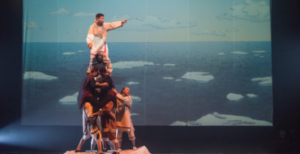
Nels Anderson looks out the window onto Davie Street with latte in hand, as he stifles a laugh. I’ve just asked him about game development in Vancouver.
“It’s great!” he says before breaking into a smile, “Or, it
used to be.” Vancouver’s game development scene has seen a rough few months. The city has been recently hit with major studio closures, layoffs, and a general development shift to Eastern Canada. In the last month alone, prominent studios like Radical, Rockstar, Microsoft, and Capcom have all tightened the belts of their Vancouver studios, some to the point of being unrecognizable compared to the studios they were. I ask Nels why he thinks this is.
“The tax incentives in the East, in places like Toronto, are certainly no small factor. But another thing is just how expensive it is to produce these major games, in Vancouver especially.”
Indie games have shown that you don’t need a massive budget to make a marketable game, and they’ve seen a surge of popularity in the last few years.
“These big studios like Activision, they need you to prove to them that so many people will play your game that it really limits what kinds of ideas you can even try and do. That’s what I like about indie development. I’ve only got to prove that, like, a handful of people will like our idea, and we can do it. And the indie scene here is really great. Honestly, I don’t know if I’d ever want to go big.”
Nels Anderson is the lead designer on
Mark of the Ninja, the soon-to-be-released 2D stealth action Xbox Live Arcade game from Klei Entertainment. “At Klei, we started working on Mark of the Ninja last year with 7 or 8 people. Now, we’re almost ready to release.” Considering most AAA titles consist of massive teams of 50+ people, and can take several years to complete, it’s not hard to see why Nels and many others like him are quite happy staying indie.
Mark of the Ninja is an interesting beast. 2D stealth games are not entirely new, but ones that take the perspective from top-down to side-scrolling are unusual. The reason for the traditional overhead perspective is that a stealth game requires you to be aware of your environment. Most video games are meant to make the player feel empowered; but in a stealth game, the fun comes from being fragile.
“Most games are reactionary. They’re about push. You get poked by the game world, and are forced to react with the tools you have. Stealth games are about pull. The player is meant to poke the game in creative ways, and the game reacts.”
I told Nels that a lot of what I like about the genre is its’ fragility, and the lack of empowerment compared to other types of games. Mark of the Ninja gives players clear feedback when the game-state changes and I asked when it could be too much.
“In a lot of older stealth games, you have no idea what any of your actions will do in a given scenario, so you might end up having to run a section multiple times just to understand what will happen. This can be frustrating to a lot of people, so in Mark of the Ninja we wanted to make it a very instantaneous kind of thing, because you are a glass cannon. If you do something, we want the results of your actions to be clearly apparent.”
Informing the player of game-state changes streamlines the game, and in fact opens up a lot more diversity in play styles. When players are given more positive feedback, they are encouraged to experiment. “People sometimes ask ‘how long is the game?’ But I can’t really give them an honest answer, because we’ve had some people play through the game quickly one way, and others take on levels very slowly and methodically, and it’s not because they’re worse players, but because they are simply choosing to take on these encounters in a completely different way.”
I admit that, to me, it’s not just about length, but whether the length of a game is justifiable. Games that pad their 60-hour campaigns with repetition tend to lose me. “I don’t like the argument that a game’s value can be judged based on dollars spent over time played,” Anderson comments.
It is the more carefully constructed games that have led to the revival of genres that have so far held a niche place in the modern gaming world.
Amnesia: The Dark Descent is one such game that brought old-school survival-horror back to life in a tight, terrifying package. The upcoming remake of primordial strategy game X-COM is riffing on these same notes. Then there are services like Kickstarter which are seeing the return of franchises and genres long-thought to be too inaccessible to gamers today. Almost all of these projects have been created by independent studios.
Maybe Mark of the Ninja will be the stealth genre’s Amnesia. Nels Anderson already has his chips down. “I’m a huge stealth fan, and I’m super excited for Dishonored. It looks fantastic. Game systems are my thing, and the guys making Dishonored have made some of the best game systems of all time.” It’s clear the design philosophy behind Mark of the Ninja is built on dynamic systems.
While Nels Anderson wrote much of the game, he was helped by former Kill Screen editor Chris Dahlen. “The game is about a clan of ninjas that have existed for centuries. They’ve been able to survive into the modern age because they’ve figured out how to harness the power of a mystical flower. When the clan is in a time of crisis, they will process the flower into an ink, and use it to tattoo a single ninja. The ink gives them vastly improved abilities, but it comes with a price: it gradually drives them insane, and ninja creed forces them to commit suicide after their mission is over. The game opens with your character getting inked.”
I comment that the concept sounds similar to the character of the Arbiter. He stares at me blankly and shrugs. “From Halo” I explain. He shrugs again. “I haven’t really played a lot of Halo. Console shooters aren’t really my thing.” I laugh. The words of a true Indie.
 Nels Anderson looks out the window onto Davie Street with latte in hand, as he stifles a laugh. I’ve just asked him about game development in Vancouver.
“It’s great!” he says before breaking into a smile, “Or, it used to be.” Vancouver’s game development scene has seen a rough few months. The city has been recently hit with major studio closures, layoffs, and a general development shift to Eastern Canada. In the last month alone, prominent studios like Radical, Rockstar, Microsoft, and Capcom have all tightened the belts of their Vancouver studios, some to the point of being unrecognizable compared to the studios they were. I ask Nels why he thinks this is.
“The tax incentives in the East, in places like Toronto, are certainly no small factor. But another thing is just how expensive it is to produce these major games, in Vancouver especially.”
Indie games have shown that you don’t need a massive budget to make a marketable game, and they’ve seen a surge of popularity in the last few years.
“These big studios like Activision, they need you to prove to them that so many people will play your game that it really limits what kinds of ideas you can even try and do. That’s what I like about indie development. I’ve only got to prove that, like, a handful of people will like our idea, and we can do it. And the indie scene here is really great. Honestly, I don’t know if I’d ever want to go big.”
Nels Anderson is the lead designer on Mark of the Ninja, the soon-to-be-released 2D stealth action Xbox Live Arcade game from Klei Entertainment. “At Klei, we started working on Mark of the Ninja last year with 7 or 8 people. Now, we’re almost ready to release.” Considering most AAA titles consist of massive teams of 50+ people, and can take several years to complete, it’s not hard to see why Nels and many others like him are quite happy staying indie.
Mark of the Ninja is an interesting beast. 2D stealth games are not entirely new, but ones that take the perspective from top-down to side-scrolling are unusual. The reason for the traditional overhead perspective is that a stealth game requires you to be aware of your environment. Most video games are meant to make the player feel empowered; but in a stealth game, the fun comes from being fragile.
“Most games are reactionary. They’re about push. You get poked by the game world, and are forced to react with the tools you have. Stealth games are about pull. The player is meant to poke the game in creative ways, and the game reacts.”
I told Nels that a lot of what I like about the genre is its’ fragility, and the lack of empowerment compared to other types of games. Mark of the Ninja gives players clear feedback when the game-state changes and I asked when it could be too much.
“In a lot of older stealth games, you have no idea what any of your actions will do in a given scenario, so you might end up having to run a section multiple times just to understand what will happen. This can be frustrating to a lot of people, so in Mark of the Ninja we wanted to make it a very instantaneous kind of thing, because you are a glass cannon. If you do something, we want the results of your actions to be clearly apparent.”
Informing the player of game-state changes streamlines the game, and in fact opens up a lot more diversity in play styles. When players are given more positive feedback, they are encouraged to experiment. “People sometimes ask ‘how long is the game?’ But I can’t really give them an honest answer, because we’ve had some people play through the game quickly one way, and others take on levels very slowly and methodically, and it’s not because they’re worse players, but because they are simply choosing to take on these encounters in a completely different way.”
I admit that, to me, it’s not just about length, but whether the length of a game is justifiable. Games that pad their 60-hour campaigns with repetition tend to lose me. “I don’t like the argument that a game’s value can be judged based on dollars spent over time played,” Anderson comments.
It is the more carefully constructed games that have led to the revival of genres that have so far held a niche place in the modern gaming world. Amnesia: The Dark Descent is one such game that brought old-school survival-horror back to life in a tight, terrifying package. The upcoming remake of primordial strategy game X-COM is riffing on these same notes. Then there are services like Kickstarter which are seeing the return of franchises and genres long-thought to be too inaccessible to gamers today. Almost all of these projects have been created by independent studios.
Maybe Mark of the Ninja will be the stealth genre’s Amnesia. Nels Anderson already has his chips down. “I’m a huge stealth fan, and I’m super excited for Dishonored. It looks fantastic. Game systems are my thing, and the guys making Dishonored have made some of the best game systems of all time.” It’s clear the design philosophy behind Mark of the Ninja is built on dynamic systems.
While Nels Anderson wrote much of the game, he was helped by former Kill Screen editor Chris Dahlen. “The game is about a clan of ninjas that have existed for centuries. They’ve been able to survive into the modern age because they’ve figured out how to harness the power of a mystical flower. When the clan is in a time of crisis, they will process the flower into an ink, and use it to tattoo a single ninja. The ink gives them vastly improved abilities, but it comes with a price: it gradually drives them insane, and ninja creed forces them to commit suicide after their mission is over. The game opens with your character getting inked.”
I comment that the concept sounds similar to the character of the Arbiter. He stares at me blankly and shrugs. “From Halo” I explain. He shrugs again. “I haven’t really played a lot of Halo. Console shooters aren’t really my thing.” I laugh. The words of a true Indie.
Nels Anderson looks out the window onto Davie Street with latte in hand, as he stifles a laugh. I’ve just asked him about game development in Vancouver.
“It’s great!” he says before breaking into a smile, “Or, it used to be.” Vancouver’s game development scene has seen a rough few months. The city has been recently hit with major studio closures, layoffs, and a general development shift to Eastern Canada. In the last month alone, prominent studios like Radical, Rockstar, Microsoft, and Capcom have all tightened the belts of their Vancouver studios, some to the point of being unrecognizable compared to the studios they were. I ask Nels why he thinks this is.
“The tax incentives in the East, in places like Toronto, are certainly no small factor. But another thing is just how expensive it is to produce these major games, in Vancouver especially.”
Indie games have shown that you don’t need a massive budget to make a marketable game, and they’ve seen a surge of popularity in the last few years.
“These big studios like Activision, they need you to prove to them that so many people will play your game that it really limits what kinds of ideas you can even try and do. That’s what I like about indie development. I’ve only got to prove that, like, a handful of people will like our idea, and we can do it. And the indie scene here is really great. Honestly, I don’t know if I’d ever want to go big.”
Nels Anderson is the lead designer on Mark of the Ninja, the soon-to-be-released 2D stealth action Xbox Live Arcade game from Klei Entertainment. “At Klei, we started working on Mark of the Ninja last year with 7 or 8 people. Now, we’re almost ready to release.” Considering most AAA titles consist of massive teams of 50+ people, and can take several years to complete, it’s not hard to see why Nels and many others like him are quite happy staying indie.
Mark of the Ninja is an interesting beast. 2D stealth games are not entirely new, but ones that take the perspective from top-down to side-scrolling are unusual. The reason for the traditional overhead perspective is that a stealth game requires you to be aware of your environment. Most video games are meant to make the player feel empowered; but in a stealth game, the fun comes from being fragile.
“Most games are reactionary. They’re about push. You get poked by the game world, and are forced to react with the tools you have. Stealth games are about pull. The player is meant to poke the game in creative ways, and the game reacts.”
I told Nels that a lot of what I like about the genre is its’ fragility, and the lack of empowerment compared to other types of games. Mark of the Ninja gives players clear feedback when the game-state changes and I asked when it could be too much.
“In a lot of older stealth games, you have no idea what any of your actions will do in a given scenario, so you might end up having to run a section multiple times just to understand what will happen. This can be frustrating to a lot of people, so in Mark of the Ninja we wanted to make it a very instantaneous kind of thing, because you are a glass cannon. If you do something, we want the results of your actions to be clearly apparent.”
Informing the player of game-state changes streamlines the game, and in fact opens up a lot more diversity in play styles. When players are given more positive feedback, they are encouraged to experiment. “People sometimes ask ‘how long is the game?’ But I can’t really give them an honest answer, because we’ve had some people play through the game quickly one way, and others take on levels very slowly and methodically, and it’s not because they’re worse players, but because they are simply choosing to take on these encounters in a completely different way.”
I admit that, to me, it’s not just about length, but whether the length of a game is justifiable. Games that pad their 60-hour campaigns with repetition tend to lose me. “I don’t like the argument that a game’s value can be judged based on dollars spent over time played,” Anderson comments.
It is the more carefully constructed games that have led to the revival of genres that have so far held a niche place in the modern gaming world. Amnesia: The Dark Descent is one such game that brought old-school survival-horror back to life in a tight, terrifying package. The upcoming remake of primordial strategy game X-COM is riffing on these same notes. Then there are services like Kickstarter which are seeing the return of franchises and genres long-thought to be too inaccessible to gamers today. Almost all of these projects have been created by independent studios.
Maybe Mark of the Ninja will be the stealth genre’s Amnesia. Nels Anderson already has his chips down. “I’m a huge stealth fan, and I’m super excited for Dishonored. It looks fantastic. Game systems are my thing, and the guys making Dishonored have made some of the best game systems of all time.” It’s clear the design philosophy behind Mark of the Ninja is built on dynamic systems.
While Nels Anderson wrote much of the game, he was helped by former Kill Screen editor Chris Dahlen. “The game is about a clan of ninjas that have existed for centuries. They’ve been able to survive into the modern age because they’ve figured out how to harness the power of a mystical flower. When the clan is in a time of crisis, they will process the flower into an ink, and use it to tattoo a single ninja. The ink gives them vastly improved abilities, but it comes with a price: it gradually drives them insane, and ninja creed forces them to commit suicide after their mission is over. The game opens with your character getting inked.”
I comment that the concept sounds similar to the character of the Arbiter. He stares at me blankly and shrugs. “From Halo” I explain. He shrugs again. “I haven’t really played a lot of Halo. Console shooters aren’t really my thing.” I laugh. The words of a true Indie. 








